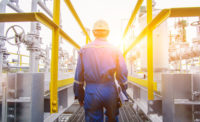Let’s face it: we are obsessed with our smart phones. We can’t live without them. We can’t go anywhere without them. When we misplace our phones, an utter panic sets in that’s only relieved when that little battery-powered device is back in our hands. Why? Because we have the overwhelming urge to be connected.
That’s right. We need to be connected. We need to scan our favorite social media sites regularly. We need to search the web for information whenever the desire strikes. We need access to apps that help us do everything from play games to find our way home. We need immediate access to our friends and family via voice or text, and sometimes we even need to pinpoint their location.
With such a strong desire to be connected, why don’t we feel this same need to be connected through the safety equipment that can protect our lives at work?
Even though we have embarked on the era of wireless gas detection and connected safety, people have been slow to adopt connectivity in a safety context. This is surprising given how easy it is to argue the benefits of being connected through a gas detector, particularly an area monitoring solution.
Components of a Connected Safety Program
Connected safety solutions in the gas detection space became a reality thanks to Internet of Things (IoT) technology, which empowers businesses to build data-sharing infrastructure. This infrastructure creates a world of devices and analytics that enable data-driven decisions to protect not just individual workers, but entire teams, facilities, and communities.
These platforms consist of three distinct components:
- Hardware and equipment
- Connectivity
- Management software
Every connected safety program starts with reliable hardware: in this case, gas detectors.
While the reliability of hardware is important, so is ensuring that you have the right hardware fit for the environment where the devices will be deployed and have the configuration flexibility to ensure proper coverage of the specific hazards affecting your site.
Essentially, without the proper hardware and equipment in place, connected safety falls apart.
These connected devices not only monitor workers, but also monitor the environment around them to collect valuable data and insights in real time. Depending on the environment, the hardware portion of a connected safety solution might include personal gas detectors, area monitors, or some combination of the two.
When it comes to area monitoring, a good, connected safety program should include a connected monitor that can share information with portable gas detectors and other on-site safety personnel to create a safety network between workers.
To maximize the effectiveness of a connected safety program, you’ll need to consider your connectivity method. Consider wi-fi, cellular, satellite, and peer-to-peer networks and determine what solution fits your application and infrastructure.
When to use area monitoring
Area gas monitors are typically used to create a buffer between workers and potential hazards. They are also useful in creating a perimeter monitoring option around an area that could cause unsafe conditions and where work is being performed.
While area monitoring can be used to create a buffer or as a perimeter monitoring option, adding additional connected options can help to improve your processes as real-time monitoring requires that monitor data is continuously collected, processed, and delivered, which ensures an uninterrupted flow of information and access to real-time, live data from any device, anytime, anywhere.
While area monitoring is a popular option for creating a buffer or perimeter monitoring solution, the most important reason to implement a connected area monitoring solution in your gas detection program is to improve your ability to act in emergency situations. For example, you can program an area monitor so real-time data notifies safety teams instantly when an area monitor senses combustible gases in an area – truly keeping your team connected.
Area gas monitors are also commonly used during plant shutdowns, as part of maintenance programs, and other temporary detection zones to improve overall connectivity between workers when fixed gas monitoring solutions aren’t an option. They are also commonly found in confined space applications as well as perimeter monitoring applications, as area gas monitors can be easily moved around as the situation and work conditions change. In many situations, they are used in addition to personal gas monitoring instruments to create a complete and well-rounded gas detection program.
Additionally, real-time area gas monitoring can be used to detect a variety of gases, and can be adjusted based on a user’s application. When looking for these specific gases, as an example, the uses for real-time area monitoring area nearly limitless, as it can be used across even more applications– spanning perimeter monitoring, general safety, emergency response, hot work, confined space entry, and more applications that require real-time information.
Connectivity options
In some cases, however, you can also upgrade your area monitoring connectivity abilities with relay control and Modbus capabilities. With these connectivity options, users can reliably integrate their gas detection program with their existing control systems. Whether they’re in industries like upstream oil or applications like emergency response, these capabilities help provide increased visibility into site conditions and worker safety.
For example, with relay control capabilities, users in industries like upstream oil, emergency response, and other team-based safety environments, among many other industrial applications, can power external equipment – including light bars, sirens, and ventilation – on or off based on specific device and sensor alarms, allowing users to ensure the proper safety response is initiated based on the type of hazard present.
Modbus capabilities, meanwhile, seamlessly integrate with systems by using standard industrial communication protocols, which provides users access to both device and sensor data for each connected peer device. This provides users in industrial settings with increased visibility into conditions across their site and allows for advanced decision logic by integrating with a user’s existing control systems.
This increased capability is also possible by taking advantage of peer-to-peer wireless capabilities offered by some companies, which help limit the number of Modbus connections required.
Software brings it all together
Each component of a connected safety program ensures workers and teams have awareness of gas hazards around them and are connected to other workers, but management software takes a connected safety program to the next level. Gas detection management software gives you unparalleled visibility into worker safety and leads to actionable insights based on the data collected by gas detectors.
Safety managers are all too familiar with time-consuming tasks like tracking regulatory compliance, identifying hazards workers are exposed to, and gathering historical data when incidents occur. Typically, management software can provide an intuitive dashboard you can use to manage workers, equipment, and hazards based on historical data.
Live monitoring software, meanwhile, builds on the historical data from management software by adding real-time monitoring. This is one of the most valuable components of a connected safety program. When a hazard occurs, live monitoring software automatically alerts a central contact via text, email, or on-screen alerts with information on the type of alarm, who is in danger, their location, and more. With this type of visibility, you can take appropriate action in seconds instead of waiting for an incident report.
Management software can also alert you if gas detectors are shut off, when a worker has spent too much time in dangerous conditions, and even if instruments are used without being calibrated. All this information allows you to take ownership of your gas detection program and improve your safety culture.



